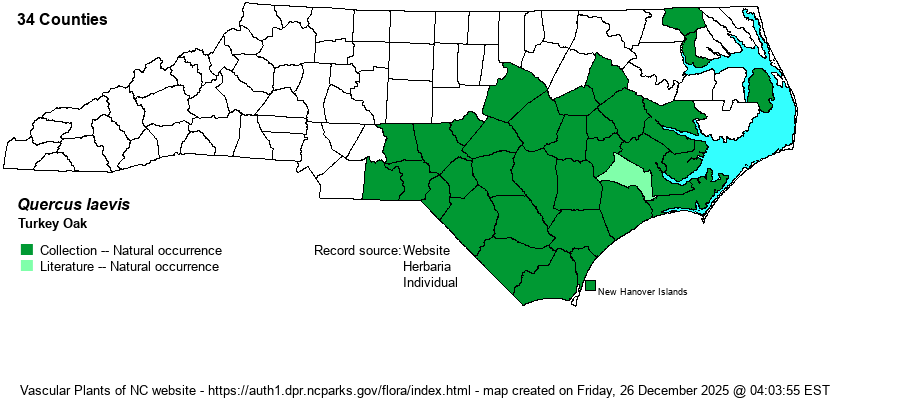| Author | Walter | |
| Distribution | Essentially throughout the Coastal Plain, but of spotty occurrence in the northern third of the province. Found in essentially all counties north to Edgecombe and Beaufort; likely absent in a few northeastern counties. Barely extends into the far eastern Piedmont, with records west to Wake, Montgomery, and Anson counties.
This is close to a Coastal Plain endemic, ranging north to southeastern VA, south to southern FL, and west only to eastern LA. It ranges inland into north-central AL.
| |
| Abundance | Very common to often abundant in the southern half of the Coastal Plain, in areas where Longleaf Pine (Pinus palustris) is present -– the Sandhills region and the southern counties from Croatan National Forest (Craven) south to the SC state line. Generally fairly common to locally common in the central Coastal Plain, but uncommon and local northward. Very rare in the Piedmont portion of the range. The most numerous of the “scrub oak” species of sandy soil in the state. | |
| Habitat | This is the dominant tree on the deeper sands of the Coastal Plain, often growing in dense stands. It is the main or only deciduous tree of the Xeric Sandhill Scrub natural community, and usually a major component of Pine/Scrub Oak Sandhill as well. It grows well on Carolina bay sand rims, Aeolian sand ridges along rivers, and in other sandy soils. Toward the Piedmont, it can be found on sandy or gravelly soil on dry slopes or low ridges. At most sites, Longleaf Pine is the primary canopy tree, though at some sites it grows well in full sun without a canopy cover at all. |
| Phenology | Flowers in April, and fruits in September and October of the following (second) year. | |
| Identification | Impossible to miss in most Coastal Plain sites with sandy soils (away from the immediate coast), this small deciduous tree grows mainly to just 45-50 feet tall. It has thick and stiff branches, and thus walking through dense stands of this tree can cause scratches on your body. The leaves resemble several other oaks with a handful of distinct lobes; the medium-sized leaves have 3-7, but often 5, lobes separated by fairly deep and rounded sinuses. They are fairly thick and shiny above, and slightly paler below. What is notable and often obvious about the leaves is that many or most on a tree have twisted petioles such that the leaf plane is perpendicular to the ground (i.e., arranged vertically). The main confusing species is Southern Red Oak (Q. falcata), which also often grows in sandy soil. However, it is a taller and more stately tree; the leaves tend to have a longer and more parallel-sided terminal lobe and stubbier and more triangular side lobes, and considerable hairiness on the undersides of the leaves. | |
| Taxonomic Comments | None
| |
| Other Common Name(s) | American Turkey Oak | |
| State Rank | S5 | |
| Global Rank | G5 | |
| State Status | | |
| US Status | | |
| USACE-agcp | | |
| USACE-emp | | |

